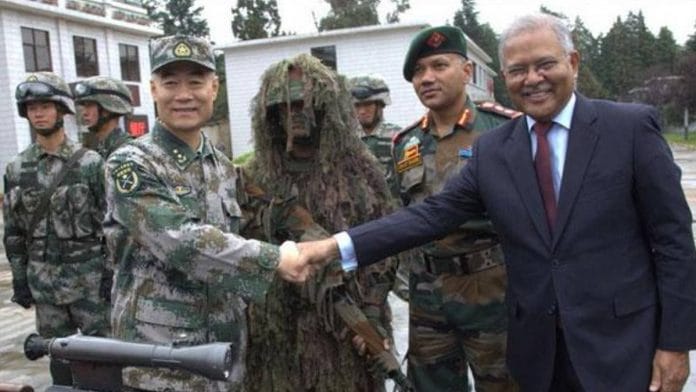New Delhi: China is now taking “first-mover advantage” and asserting itself in the world by deploying “wolf warrior diplomacy” even as greater challenges lie ahead in the coming future between New Delhi and Beijing, according to Ashok Kantha, former Indian ambassador to China.
Speaking to ThePrint, Kantha said the very fact that China has been able to come out of the pandemic quickly while the rest of the world is struggling is what Beijing is taking advantage of and that can be seen in how the country is behaving with regards to Hong Kong, Taiwan and South China Sea or with regards to the recent border tensions with India along the Line of Actual Control (LAC).
“Chinese side is becoming more assertive in its foreign policy behaviour. There is talk of wolf warrior diplomacy, even within China. China seems to look upon the Covid period as period of strategic opportunity to expand its influence. China was the original epicentre of Covid-19, but it also became the first country to recover from the novel coronavirus while rest of the world is still struggling… This gives China a first-mover advantage so to say and they will like to take advantage and utilise this opportunity,” he said in an interview over Skype.
According to Kantha, who is director of the Institute of Chinese Studies, a greater concern lies in the fact that a “large gap” has emerged between India and China in terms of capabilities.
“I am worried that will further widen between our two countries … Looking ahead I expect a period of greater challenge in India-China relations,” he said.
He also said the “strategic rivalry” between the US and China will have a spillover effect on ties between New Delhi and Beijing.
“Strategic rivalry between the US and China are becoming more and more acute. This will generate greater pressure on India and China to deal with. We have to factor in all these considerations,” he added.
Also read: China’s aggression against India, Hong Kong, US comes from sense of siege on pandemic origin
‘China violating basic protocol’
On the recent border flareup between India and China at the Line of Actual Control (LAC), especially in Galwan Valley of Ladakh, Kantha said it “is more serious” than any of the previous border face-offs Indian and Chinese troops have had.
“It is not a routine occurrence … We’ve seen greater aggression on part of Chinese troops. We’ve seen intrusions taking place in Galwan River valley where we did not anticipate the differences. The situation is dragging on,” he said.
The former Secretary (East) at the Ministry of External Affairs also stressed that this time the Chinese “violated” the basic protocol that both sides maintain when it comes to border issues.
“They are engaging in fairly aggressive behaviour resulting in large number of injuries on our side, going by media reports,” he highlighted.
Also read: China’s animosity record towards India reflects wolf warrior diplomacy: Taiwan representative
‘Breakthrough on border dispute has eluded India, China’
While both sides have not exchanged any fire since 1975, Kantha said there has been a “stalemate” on the issue of boundary resolution between India and China.
“As far as the resolution of the boundary question is concerned, we are at a stalemate. We have not seen any breakthrough since 2005 when we signed the agreement on political parameters and guiding principles… A basic breakthrough has eluded us,” the veteran diplomat said.
Referring to the five agreements signed between both sides on the issue of border affairs, Kantha said the Chinese side has not been adhering to the protocols laid down in these pacts.
“It’s important that these agreements (are) adhered to. That’s not happening. Protocols that have been put in place to govern the behaviour of troops in border areas in recent instances, Chinese side has not been complying with those requirements,” he added.
The five pacts, which seeks to maintain ‘peace and tranquillity’ in the border areas, signed between both sides since 1993 are — Agreement on Maintenance of Peace and Tranquility along the Line of Actual Control in the India-China Border Areas (1993); Agreement on Confidence Building Measures in the Military Field along the LAC (1996); Protocol on Modalities for the Implementation of the Confidence Building Measures in the Military Field along the LAC (2005); Agreement on the Establishment of a Working Mechanism for Consultation and Coordination on India-China Border Affairs (2012) and Border Defence Cooperation Agreement (2013).
“We need to focus more on the boundary question… We need to have some incremental progress on this issue. We need to put at least some difference behind us,” he added.
Also read: China’s muscle-flexing in Ladakh doesn’t mean there’s a war coming, says former NSA






